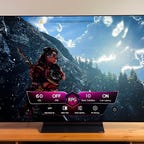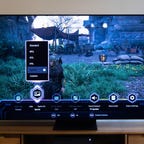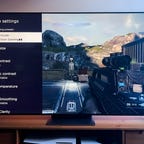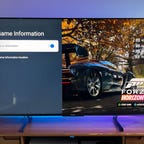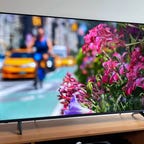Best Gaming TV for 2024: Low Input Lag and High Picture Quality
Our picks of the best gaming TVs of 2024 boast great image quality and minimal delay, to enhance your gaming experience.
Our Picks
If you're looking to buy a great TV, any of the best TVs of 2024 should be good for you. But if you're looking to buy the best gaming TV for your home entertainment setup, you'll need to consider a few more things. Nearly all modern TVs get a gaming mode with reduced input lag; sharper image quality; and excellent resolution, color, contrast and brightness (all factors that make a model well-suited for playing video games). Your TV also needs to have HDMI 2.1 to get the best gaming experience. If you're looking to pair up your gaming TV with a PlayStation 5 or Xbox Series X -- or both -- you'll need a TV with HDMI 2.1, 120 Hz and variable refresh rates.
During an intense gaming session, quick reaction speeds are crucial. There's a feedback loop connecting your brain, your fingers, the game controller and the action you see playing out on the TV screen. You'll want the best performance all around so you're properly immersed. If there's a lag or delay, the thrilling immediacy of the playing experience will be ruined. Not to mention, your gameplay performance will suffer. It takes mere milliseconds for a video signal to travel from your console through the HDMI input on your TV to display on the screen. Any delay in that travel can be downright deadly to your in-game character. Those dreadful milliseconds of delay? That's input lag.
What's the best gaming TV right now?
LG's C3 may be on the expensive side, but it pairs high-end image quality with impressive gaming features on every input. All of the TV's HDMI ports include the latest version of the HDMI standard: 2.1. That means its HDMI ports can handle 4K at 120 frames per second and variable refresh rate (including Nvidia G-Sync and AMD FreeSync), as well as enhanced audio return channel and automatic low latency mode (auto game mode).
In other words, it can take advantage of the latest graphics features available from PS5 and Xbox Series X and S consoles, as well as high-end PC graphics cards. The C3 is rare among high-end TVs in that all four of its HDMI ports support 4K/120 -- great for hard-core gamers with multiple next-gen devices. The TV also comes with a specialized Game Optimizer settings suite. It's a great choice for gamers who want an excellent picture and aren't afraid to splurge to get it.
Best gaming TVs of 2024
The following TVs, featured at the top of the page, deliver either the lowest lag I've measured among the TVs I've reviewed, the best picture quality for the money, or a combination of both. Unless otherwise noted, prices shown below are for the 65-inch sizes.
The C3, like the C2 before it, is an excellent gaming TV, and LG hasn't done much to change it. I still love all the options in the Game Optimizer menu, which gathers all the gaming settings in one place and verifies refresh rate, VRR status and more at a glance. I also appreciated the ability to edit the gaming dashboard to swap in more status indicators (resolution, Dolby Atmos and so on), but I'm pretty nerdy like that.
The Dark Room mode is designed to reduce eye fatigue, but it also dulls the image, so I'd avoid using it unless you need to. Among the various gaming image modes, I liked Standard best for most games, with its balance of shadow detail and contrast. FPS is best if you want more visibility into shadows, or you can just crank up the Black Stabilizer control (at the expense of a washed-out image).
Buried within Game Optimizer is another setting, labeled "Reduce input delay (input lag)," with two options: Standard and Boost. The former, which is the default for any game, serves up an excellent input lag result similar to past LG OLED models: just 13.5ms for both 1080p and 4K HDR sources. Engaging Boost cuts lag even further, to just under 10ms for both. The catch is that Boost is available only for 60Hz sources, so you can't use it with 120Hz games or VRR. And no, I don't think many humans would notice the extra 3ms of lag.
Best non-OLED gaming TV
Samsung QN65QN90B
Although a few cheaper TVs deliver lower lag than the QN90B, the difference boils down to tenths of a millisecond, as you can see from the chart above. The picture quality of this higher-end TV runs circles around those competitors, thanks to mini-LED technology. Like LG, Samsung has a tricked-out gaming menu with indicators for refresh rate, HDR and more, as well as gaming-specific picture modes. It also offers a built-in extra that LG doesn't: Xbox cloud gaming.
Samsung produces several QLED TVs, but the QN90B is among the highest-end, aside from versions with 8K resolution. This is a 2022 model, but the newer version, the QN90C, looks very similar in terms of features and while we haven't reviewed it, we expect it to deliver similar image quality. It's also significantly more expensive.
Best value gaming TV
TCL 6-Series Roku TV
One of our favorite TVs overall for the money happens to be an excellent gaming TV as well. This TCL supports all the high-end gaming extras you expect, including 4K, 120Hz input and variable refresh rate. Our tests of its gaming picture revealed excellent overall quality, in particular shadow detail.
This TV has an excellent image thanks to mini-LED tech and well-implemented full-array local dimming that helps it run circles around just about any other TV at this price. It improves upon the previous R635 series with improved gaming extras and a new center-mount stand that you can elevate to make room for a soundbar, although the new 85-inch size has standard legs. Finally, the Roku TV operating system is our hands-down favorite.
Note that in addition to the R635, which this TV replaces, other versions of the 6-Series were released in 2021 and remain on sale. The R646 series uses the Google TV operating system but otherwise has similar specifications to the R655 models reviewed here. The R648 series has an 8K resolution and is significantly more expensive.
Second-best value gaming TV
Hisense U8K
Hisense offers more gaming features than on last year's U8H, though they aren't quite as varied as what you'll find with Samsung, LG or TCL. When I connected an Xbox Series X, hitting the Menu key summoned a special gaming menu along the bottom that indicates current gaming status, including real-time frames per second, HDR and other features.
Unlike the competition, Hisense doesn't include special picture modes for gaming, although you can move to another menu to toggle away from game mode and choose others, such as HDR Sport or Filmmaker. I found this arrangement confusing, especially when the pop-up "Optimized for game settings" appeared in those other modes. I much prefer to have separate discrete modes I know are designed for gaming.
There is a single toggle for "dark detail" that brings up shadow detail, and you can tweak a special Brightness setting to adjust it. I was annoyed that a few other settings -- Picture Size, Screen Position and High Refresh Rate Mode -- were inactive. Don't worry about that last one, however. According to my Xbox's menu, the U8K is capable of supporting every format the box can put out, including 4K/120Hz and Dolby Vision. I also measured a solid 14ms lag in game mode for both SDR and HDR.
Comparing the game mode image quality between the Hisense, TCL and LG C3, the story was similar to what I saw with TV and movies. The C3 looked the best overall when I played Starfield, and the TCL had the brightness advantage, but the image of the Hisense looked a bit more balanced to my eye, with more natural color, than did the TCL's. I bumped up the local dimming setting to High on the Hisense to give it a bit more pop, but overall I preferred the more dynamic picture of the TCL for games in my side-by-side comparison.
Best budget gaming TV
Vizio V-Series
The Vizio V-Series costs hundreds less than any of the TVs above, its image quality can't compete and it lacks 4K, 120Hz input, but for a budget model, its gaming chops are top-notch. It's the only budget TV we've seen that supports variable refresh rate and its overall image quality was a cut above similarly priced models from TCL, Hisense and others.
Vizio hasn't announced a 2024 version of the V-Series yet. The price listed below is for the 50-inch size.
How we test gaming TVs
Our TV reviews follow a rigorous, unbiased evaluation process honed over nearly two decades of TV reviews. Our primary TV test lab has specialized equipment for measuring light and color, including a Konica Minolta CS-2000 spectroradiometer, a Murideo Sig-G 4K HDR signal generator and an AVPro Connect 8x8 4K HDR distribution matrix. We use Portrait Displays CalMan Ultimate software to evaluate every TV we review. In every CNET TV review, three or more similar TVs are compared side by side in various lighting conditions playing different media, including movies, TV shows and games, across a variety of test categories, from color to video processing to gaming to HDR. Our reviews also account for design, features, smart TV performance, HDMI input and gaming compatibility, as well as other factors.
Measuring input lag (in milliseconds) is an important component of our process for testing gaming TVs.
Measuring TVs' input lag
| TV model | On (4K HDR) | Off (4K HDR) | On (1080p) | Off (1080p) |
|---|---|---|---|---|
| LG OLED65C3 | 10.2 | 13.60 | 9.93 | 13.50 |
| Amazon Fire TV 4-Series | 10.03 | 119.23 | 34.80 | 102.20 |
| Samsung QN55Q60B | 10.10 | 68.63 | 10.00 | 87.80 |
| TCL 50S455 | 10.13 | 49.90 | 10.23 | 33.27 |
| Samsung QN65QN90B | 10.50 | 74.30 | 10.73 | 95.00 |
| Vizio V550M | 10.43 | 67.70 | 10.63 | 51.57 |
| Hisense 50A6H | 10.53 | 119.27 | 10.80 | 43.23 |
| TCL 65R655 | 10.90 | 11.40 | 11.27 | 11.37 |
| Sony KD55X80K | 11.67 | 132.63 | 11.93 | 132.77 |
| Vizio M65QXM-K03 | 15.10 | 127.37 | 15.33 | 60.10 |
| Hisense 65U8K | 14.37 | 108.73 | 14.07 | 108.73 |
| Sony KD-65X95K | 18.13 | 144.53 | 18.03 | 161.20 |
Check out our page on how we test TVs for more details.
Input lag will often be lower in game mode than in any other mode on your TV. Here are a few more gaming-specific aspects we looked at for each TV.
How to turn on game mode. In most cases, viewing in game mode isn't automatic so you'll have to turn it on manually, and sometimes the gaming monitor setting can be difficult to find. Many use a picture mode called "Game" while some, like Samsung and Vizio, let you apply game mode to any setting.
Game mode makes a difference, except when it doesn't. As you can see in the table above, many TVs cut lag substantially when you turn on game mode, but plenty don't. In general, expensive TVs with elaborate video processing get more of a benefit when you engage game mode.
Most TV game modes are good enough for most gamers. No matter how twitchy you are, it's going to be tough to tell the difference between 13 and 30 milliseconds of input lag. Many gamers won't even be able to discern between having game mode on and off -- it all depends on the game and your sensitivity to lag.
Turning game mode on can hurt image quality (a little). TV-makers' menus often refer to reduced picture quality. Reduced picture quality is generally the result of turning off that video processing. In my experience, however, the differences in image quality are really subtle with console gaming, and worth the trade-off if you want to minimize lag for a great gaming experience.
4K HDR gaming lag is different from 1080p. The display resolution you play at has an impact, and since new consoles prominently feature 4K HDR output for games, I started testing for 4K HDR lag in 2018. In general, the numbers are similar to the lag with standard 1080p resolution, but as you can see from the chart above, there are exceptions.
Testing is an inexact science. I use a Leo Bodnar lag tester. Here's how it works, and how I use it. You might see different lag test results from different review outlets, which may use Bodnar or another method.
How to choose a gaming TV
With all of the TVs available today, and all of the technical terms and jargon associated with television technology, it can be tough to figure out what's important. Here's a quick guide to help cut through the confusion.
Price: TVs range in price from $100 to more than $2,000. Smaller screens are cheaper, well-known brands are more expensive and spending more money can also get you better image quality. Most entry-level TVs have a good enough picture for most people, but TVs last a long time, so it might be worth spending more to get a better picture. It's also best to shop for a TV in the fall, when prices are lower.
Screen size: Bigger is better in our book. We recommend a size of at least 43 inches for a bedroom TV and at least 55 inches for a living room or main TV -- and 65 inches or larger is best. More than any other "feature," stepping up in TV screen size is the best use of your money. One of the most common post-TV-purchase complaints we've heard is from people who didn't go big enough. We rarely hear people complain that their TV is too large.
Capability: Among entry-level TVs the most important feature is what kind of smart TV system the TV uses. Among midrange models, look for features including full-array local dimming, mini-LED and 120Hz refresh rate, which (unlike some other extras) do help improve the picture in our experience. Among high-end TVs, OLED technology is your best bet.
For more TV buying advice, check out our guide on how to buy a TV.


